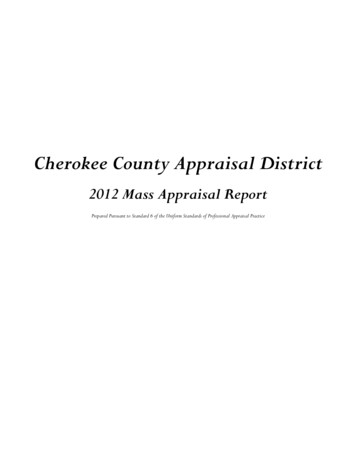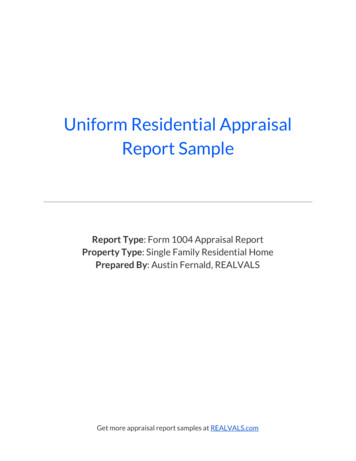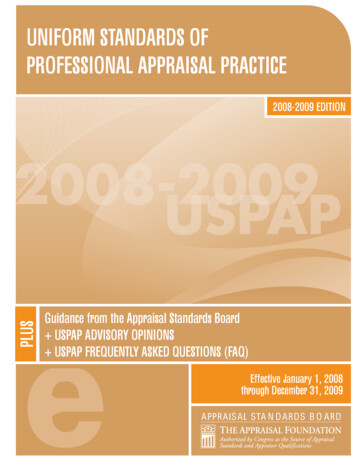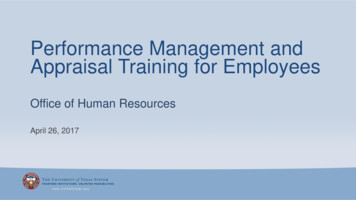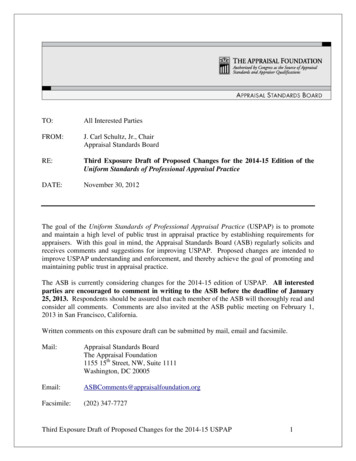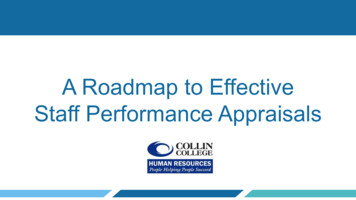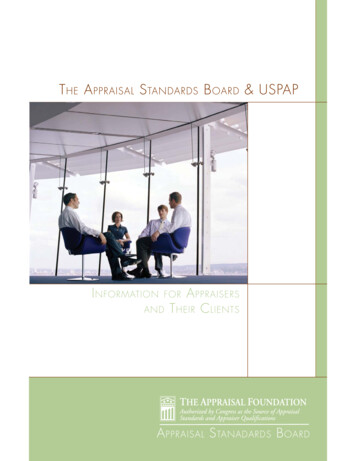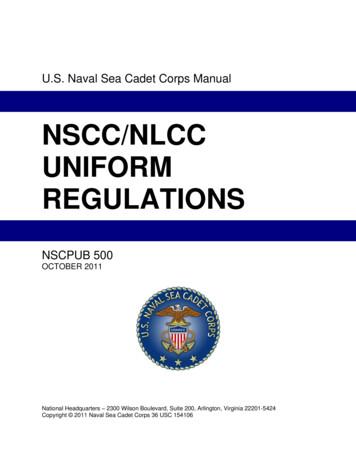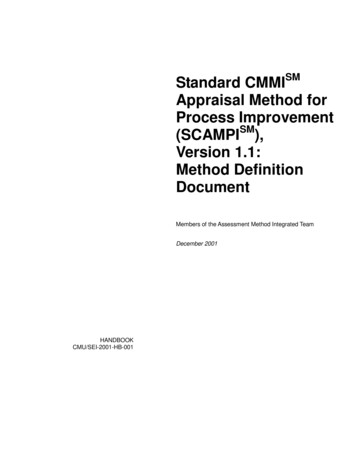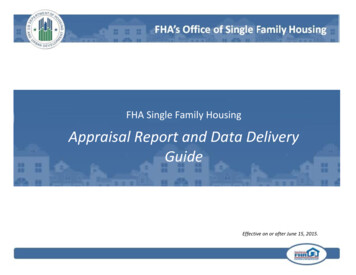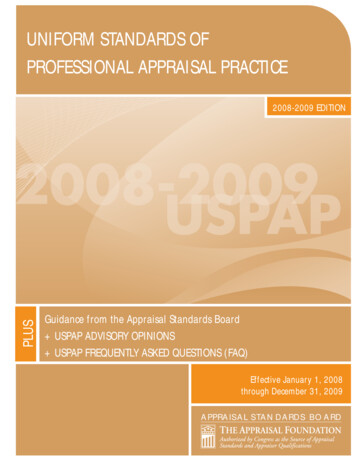
Transcription
UNIFORM STANDARDS OFPROFESSIONAL APPRAISAL PRACTICE2008-2009 EDITIONPLUS2Guidance from the Appraisal Standards Board USPAP ADVISORY OPINIONS USPAP FREQUENTLY ASKED QUESTIONS (FAQ)eEffective January 1, 2008through December 31, 2009APPRAISAL STANDARDS BOARD
UNIFORMSTANDARDS lished in the United States of America.ISBN: 978-0-9798728-0-8All rights reserved.No parts of this publication may be reproduced, stored in a retrieval system,or transmitted in any form or by any means, electronic, mechanical,photocopy, recording or otherwise, without the prior written consent of thepublisher.EFFECTIVE:January 1, 2008 throughDecember 31, 2009
FOREWORDFOREWORDThe Appraisal Standards Board (ASB) of The Appraisal Foundation develops, interprets, and amends theUniform Standards of Professional Appraisal Practice (USPAP) on behalf of appraisers and users of appraisalservices. The 2008-2009 Edition of USPAP (2008-2009 USPAP) is effective January 1, 2008 throughDecember 31, 2009.USPAP has five sections: DEFINITIONS, PREAMBLE, Rules, Standards and Standards Rules, and Statementson Appraisal Standards. For convenience of reference, USPAP is published with this Foreword and a Table ofContents. These reference materials are forms of “Other Communications” provided by the ASB for guidanceonly and are not part of USPAP.It is important that individuals understand and adhere to changes in each edition of USPAP. State and federalregulatory authorities enforce the content of the current or applicable edition of USPAP.History of USPAPThese Standards are based on the original Uniform Standards of Professional Appraisal Practice developed in1986–87 by the Ad Hoc Committee on Uniform Standards and copyrighted in 1987 by The AppraisalFoundation. The effective date of the original Uniform Standards was April 27, 1987. Prior to the establishmentof the ASB in 1989, USPAP had been adopted by major appraisal organizations in North America. USPAPrepresents the generally accepted and recognized standards of appraisal practice in the United States.At its organizational meeting on January 30, 1989, the Appraisal Standards Board unanimously approved andadopted the original USPAP as the initial appraisal standards promulgated by the ASB. USPAP may beamended, interpreted, supplemented, or retired by the ASB after exposure to the appraisal profession, users ofappraisal services, and the public in accordance with established rules of procedure.GuidanceThe ASB issues guidance in the form of Advisory Opinions, USPAP Frequently Asked Questions (FAQ) andmonthly questions and responses “USPAP Q&A.” These communications do not establish new Standards orinterpret existing Standards and are not part of USPAP. They illustrate the applicability of Standards in specificsituations and offer advice from the ASB for the resolution of appraisal issues and problems.The USPAP Q&A is published monthly and available on The Appraisal Foundation website. These questionsand responses are compiled and published in the USPAP Frequently Asked Questions.Changes to USPAPOver the years, USPAP has evolved in response to changes in appraisal practice. The ASB has developed aprocess for developing both Standards and guidance based, in part, on written comments submitted in responseto exposure drafts and oral testimony presented at public meetings.Contacting the Appraisal Standards BoardThe ASB invites questions about USPAP, commentary on USPAP and proposed changes to USPAP from allinterested parties, including appraisers, state enforcement agencies, users of appraisal services, and the public. The Appraisal FoundationU-i
FOREWORDIf you have any comments, questions, or suggestions regarding USPAP, please contact the ASB.Appraisal Standards BoardThe Appraisal Foundation1155 15th Street, NW, Suite 1111Washington, DC 20005Phone: 202-347-7722Fax: 202-347-7727E-Mail: n.orgU-ii The Appraisal Foundation
FOREWORD2007 APPRAISAL STANDARDS BOARD MEMBERSGregory J. Accetta – ChairNoreen Dornenburg – Vice ChairPaula K. KonikoffDawn M. Molitor-GennrichWilliam J. Pastuszek, Jr.William Henry Riley(The 2008-2009 USPAP was adopted by the 2007 Appraisal Standards Board on June 8, 2007.)2006 APPRAISAL STANDARDS BOARD MEMBERSGregory J. Accetta – ChairPaula K. Konikoff – Vice ChairJames D. CannonCarla G. GlassDawn M. Molitor-GennrichWilliam J. Pastuszek, Jr.Danny K. Wiley The Appraisal FoundationU-iii
FOREWORDPast Appraisal Standards Board Officers and Members1989 Board MembersCharles B. Akerson - ChairJohn J. Leary - Vice ChairSherwood DaringtonDaniel A. Dinote, Jr.John L. Gadd1995 Board MembersSherwood Darington - ChairTim Leberman - Vice ChairDaniel A. Dinote, Jr.W. David SnookLaurie Van Court1990 Board MembersJohn J. Leary - ChairSherwood Darington - Vice ChairDaniel A. Dinote, Jr.John L. GaddCharles B. Akerson1996 Board MembersW. David Snook - ChairLaurie Van Court - Vice ChairStephanie ColemanTim Leberman1991 Board MembersJohn J. Leary - ChairSherwood Darington - Vice ChairDaniel A. Dinote, Jr.John L. GaddCharles B. Akerson1992 Board MembersJohn J. Leary - ChairSherwood Darington - Vice ChairDaniel A. Dinote, Jr.John L. GaddRitch LeGrand1993 Board MembersRitch LeGrand - ChairSherwood Darington - Vice ChairDaniel A. Dinote, Jr.John L. GaddJohn J. Leary1994 Board MembersSherwood Darington - ChairDaniel A. Dinote, Jr. - Vice ChairTim LebermanJohn J. LearyRitch LeGrandU-iv1997 Board MembersW. David Snook - ChairLaurie Van Court - Vice ChairStephanie ColemanKenneth J. KaiserTim Leberman1998 Board MembersTim Leberman - ChairKenneth J. Kaiser - Vice ChairStephanie ColemanYale KramerW. David SnookLaurie Van Court1999 Board MembersKenneth J. Kaiser - ChairTim Leberman - Vice ChairYale KramerLawrence E. OfnerW. David SnookLaurie Van Court2000 Board MembersKenneth J. Kaiser - ChairYale KramerLawrence E. OfnerW. David SnookRichard A. SouthernLaurie Van Court*No Vice Chair2001 Board MembersKenneth J. Kaiser - ChairRichard A. Southern - Vice ChairThomas O. JacksonCarla G. GlassLawrence E. OfnerDanny K. Wiley2002 Board MembersDanny K. Wiley - ChairLawrence E. Ofner - Vice ChairCarla G. GlassThomas O. JacksonKenneth J. KaiserRichard A. Southern2003 Board MembersDanny K. Wiley - ChairLawrence E. Ofner - Vice ChairGregory J. AccettaCarla G. GlassPaula K. KonikoffDawn M. Molitor-Gennrich2004 Board MembersDanny K. Wiley – ChairCarla G. Glass – Vice ChairGregory J. AccettaPaula K. KonikoffDawn M. Molitor-GennrichLawrence E. Ofner2005 Board MembersCarla G. Glass – ChairGregory J. Accetta – Vice ChairJames D. CannonPaula K. KonikoffDawn M. Molitor-GennrichDanny K. Wiley The Appraisal Foundation
FOREWORDREVISIONS TO USPAP AND USPAP ADVISORY OPINIONSThe 2008-2009 edition of USPAP is the result of two exposure drafts, issued on December 15, 2006 and March5, 2007. Based on written responses, public testimony at Appraisal Standards Board (ASB) public meetings,and extensive deliberation by the Board, the ASB adopted the 2008-2009 USPAP on June 8, 2007. The adoptedchanges are incorporated in the 2008-2009 USPAP and associated guidance effective January 1, 2008 throughDecember 31, 2009.KEY CHANGES IN USPAP AND ADVISORY OPINIONSDEFINITIONS: The definition of Supplemental Standards was deleted. The majority of appraisers, users of appraisal services, and enforcement officials recognize thatSupplemental Standards include laws and regulations. Appraisers must comply with laws andregulations because of the nature of law itself, not because of USPAP. Thus, continued use ofSupplemental Standards as a defined term was unnecessary. Descriptions of “laws” and “regulations” are provided in the SCOPE OF WORK RULE based on theirrespective Black’s Law Dictionary definitions. The deletion of the definition removes specific recognition of Government Sponsored Enterprises(GSE) as a source of assignment conditions because they provide guidelines, which are not laws orregulations. However, the edits do not change 1) the necessity for an appraiser acting in compliancewith USPAP to follow GSE guidelines where applicable; and, 2) the enforcement of USPAP, includingthose items necessary for competent performance and meaningful reporting.DEFINITIONS: The definition of Advocacy was deleted. Edits to the Conduct Section of the ETHICS RULE rendered the definition unnecessary because theterm is used with its common English meaning.ETHICS RULE: Edits were made to the Conduct section of the ETHICS RULE related to advocacy. The edits make clear that advocating the cause or interest of any party or issue contradicts therequirement for independence. The changes do not diminish the prohibition against advocacy inappraisal practice; advocacy remains unacceptable.SUPPLEMENTAL STANDARDS RULE: The SUPPLEMENTAL STANDARDS RULE was deletedbecause the other requirements of USPAP eliminate the need for the Rule. The duty for the appraiser to comply with applicable assignment conditions is embedded in theobligations to provide ethical and competent services. The SCOPE OF WORK RULE requiresappraisers to identify the problem to be solved, which includes identification of assignment conditions.In communicating assignment results, the requirement that reports be meaningful and not misleadingcreates an obligation to comply with applicable laws, regulations, and guidelines.Associated Changes to the SCOPE OF WORK RULE, the Conduct section of the ETHICS RULE andthe COMPETENCY RULE: The SCOPE OF WORK RULE has been edited to replace the term “Supplemental Standards” with“laws and regulations.” This change highlights and focuses the SCOPE OF WORK RULE onassignment conditions that have legal force. The SCOPE OF WORK RULE states that it is the appraiser’s responsibility to identify the problem tobe solved. Therefore, the Conduct section of the ETHICS RULE was modified to remove text thatidentifies the need for an agreement between the client and appraiser when accepting an assignmentwhen supplemental standards apply. Text was added to the COMPETENCY RULE to acknowledge that appraisers must recognize andcomply with laws and regulations that apply in an assignment. Laws and regulations may apply to theactions of the appraiser, or may apply to how an appraisal must be completed. The Appraisal FoundationU-v
FOREWORDWith these changes, USPAP continues to require adherence to those assignment conditions that are necessaryfor proper development and reporting.Standards Rule 2-3, Standards Rule 3-3, Standards Rule 5-3, Standards Rule 6-9, Standards Rule 8-3,and Standards Rule 10-3: Edits were made to remove the requirement that the signing appraiser have areasonable basis to believe that work done by others was credible. Language was added clarifying that thesigning appraiser(s) must not rely on the work of others if that appraiser has a reason to doubt that the work iscredible.Standards Rules 7-3(a), 8-2(a)(ix), 6-3(b), and 6-8(n): Edits were made to the personal property appraisalrequirements to identify and report the highest and best use: The edits do not change the substance of the requirements, but better align the language withterminology more commonly used in personal property appraisal.Standards Rule 1-6(b), Standards Rule 6-7(a), Standards Rule 7-6(b), and Standards Rule 9-5(b): Editswere made to the requirements for reconciliation of the approaches used to arrive at the value in each StandardsRule. The Comment to Standards Rule 1-6 and the Comment to Standards Rule 7-6 were deleted. The edits were made for clarity and consistency.Standards Rules 2-2(a)(vi), 2-2(b)(vi), & 2-2(c)(vi), Standards Rule 6-8(g), and Standards Rules 8-2(a)(vi),8-2(b)(vi), & 8-2(c)(vi): The phrase “property use conditions” was shortened to “property.” The portion of theComment to each Standards Rule requiring reiteration of the report date and effective date of the appraisal wasdeleted. The edits were made for clarity and consistency.STATEMENT 10 (Retired): The Statement titled Assignments for Use by a Federally Insured DepositoryInstitution in a Federally Related Transaction was retired. Some of the issues addressed in STATEMENT 10have been incorporated into the new Advisory Opinion 30, Appraisals for Use by a Federally RegulatedFinancial Institution. The Statement did not distinguish between laws (such as FIRREA), regulations and guidelines (such asthe Interagency Appraisal and Evaluation Guidelines) resulting in confusion for both appraisers andusers of appraisal services. The format and complexity of STATEMENT 10 were obstacles to its understanding and effectiveenforcement. Substantial editing of STATEMENT 10 would not have resulted in increased understanding.ADVISORY OPINION 30 (New): Appraisals for Use by a Federally Regulated Financial Institution replacesthe advice from retired STATEMENT 10 and addresses adherence to the applicable laws, regulations, andguidelines of the federal financial institution regulatory agencies required for proper appraisal development andreporting.ADVISORY OPINION 5 (Retired): Assistance in the Preparation of an Appraisal was retired because of theneed to update and expand its guidance. The new Advisory Opinion 31, Assignments Involving More than OneAppraiser meets these needs.ADVISORY OPINION 31 (New): Assignments Involving More than One Appraiser offers advice on recordkeeping, signature and certification requirements in assignments that involve more than one appraiser.ADVISORY OPINION 32 (New): Ad Valorem Property Tax Appraisal and Mass Appraisal Assignmentsillustrates the application of USPAP in assignments performed by appraisers for ad valorem taxation.U-vi The Appraisal Foundation
FOREWORDNote: Administrative edits also were made to USPAP and all guidance material, including the USPAP AdvisoryOpinions and USPAP Frequently Asked Questions, for conformity and consistency. The Appraisal FoundationU-vii
FOREWORDTABLE OF CONTENTSUNIFORM STANDARDS OF PROFESSIONAL APPRAISAL PRACTICEDEFINITIONS .U-1PREAMBLE.U-6ETHICS RULE.U-7COMPETENCY RULE.U-11SCOPE OF WORK RULE.U-12JURISDICTIONAL EXCEPTION RULE .U-14Standards and Standards RulesSTANDARD 1: REAL PROPERTY APPRAISAL, DEVELOPMENT.U-15STANDARD 2: REAL PROPERTY APPRAISAL, REPORTING.U-21STANDARD 3: APPRAISAL REVIEW, DEVELOPMENT AND REPORTING .U-30STANDARD 4: REAL PROPERTY APPRAISAL CONSULTING, DEVELOPMENT .U-36STANDARD 5: REAL PROPERTY APPRAISAL CONSULTING, REPORTING .U-39STANDARD 6: MASS APPRAISAL, DEVELOPMENT AND REPORTING.U-43STANDARD 7: PERSONAL PROPERTY APPRAISAL, DEVELOPMENT .U-54STANDARD 8: PERSONAL PROPERTY APPRAISAL, REPORTING .U-59STANDARD 9: BUSINESS APPRAISAL, DEVELOPMENT .U-68STANDARD 10: BUSINESS APPRAISAL REPORTING.U-72Statements on Appraisal StandardsStatements on Appraisal Standards (SMT) are authorized by the by-laws of The Appraisal Foundation and arespecifically for the purposes of clarification, interpretation, explanation, or elaboration of the UniformStandards of Professional Appraisal Practice (USPAP). Statements have the full weight of a Standards Ruleand can be adopted by the Appraisal Standards Board only after exposure and comment.Each Statement is labeled as to its applicability to the various appraisal disciplines. The abbreviations are:x x x x Real Property – RPPersonal Property – PPIntangible Property – IP (includes business interests)All disciplines – ALLSMT-1SMT-2SMT-3SMT-4SMT-5SMT-6Appraisal Review—Clarification of Comment on Standards Rule 3-1(g) - Retired .U-78Discounted Cash Flow Analysis (RP) .U-79Retrospective Value Opinions (RP, PP).U-82Prospective Value Opinions (RP, PP) .U-84Confidentiality Section of the ETHICS RULE - Retired .U-86Reasonable Exposure Time in Real Property and Personal Property MarketValue Opinions (RP, PP).U-87SMT-7 Permitted Departure from Specific Requirements in Real Property and Personal PropertyAppraisal Assignments - Retired.U-89SMT-8 Electronic Transmission of Reports - Retired .U-90SMT-9 Identification of Intended Use and Intended Users (ALL).U-91SMT-10 Assignments for Use by a Federally Insured Depository Institution in a FederallyRelated Transaction - Retired.U-95U-viii The Appraisal Foundation
DEFINITIONS1UNIFORM STANDARDS OF PROFESSIONAL APPRAISAL PRACTICE2as promulgated by theAppraisal Standards Board ofThe Appraisal Foundation345DEFINITIONS6For the purpose of the Uniform Standards of Professional Appraisal Practice (USPAP), the followingdefinitions 031323334APPRAISAL: (noun) the act or process of developing an opinion of value; an opinion of value.(adjective) of or pertaining to appraising and related functions such as appraisal practice orappraisal services.Comment: An appraisal must be numerically expressed as a specific amount, as a range ofnumbers, or as a relationship (e.g., not more than, not less than) to a previous value opinion ornumerical benchmark (e.g., assessed value, collateral value).APPRAISAL CONSULTING: the act or process of developing an analysis, recommendation, or opinion tosolve a problem, where an opinion of value is a component of the analysis leading to the assignment results.Comment: An appraisal consulting assignment involves an opinion of value but does not havean appraisal or an appraisal review as its primary purpose.APPRAISAL PRACTICE: valuation services performed by an individual acting as an appraiser, including butnot limited to appraisal, appraisal review, or appraisal consulting.Comment: Appraisal practice is provided only by appraisers, while valuation services areprovided by a variety of professionals and others. The terms appraisal, appraisal review, andappraisal consulting are intentionally generic and are not mutually exclusive. For example, anopinion of value may be required as part of an appraisal review and is required as acomponent of the analysis in an appraisal consulting assignment. The use of othernomenclature for an appraisal, appraisal review, or appraisal consulting assignment (e.g.,analysis, counseling, evaluation, study, submission, or valuation) does not exempt anappraiser from adherence to the Uniform Standards of Professional Appraisal Practice.APPRAISAL REVIEW: the act or process of developing and communicating an opinion about the quality ofanother appraiser’s work that was performed as part of an appraisal, appraisal review, or appraisal consultingassignment.Comment: The subject of an appraisal review assignment may be all or part of a report,workfile, or a combination of these.APPRAISER: one who is expected to perform valuation services competently and in a manner that isindependent, impartial, and objective.USPAP 2008-2009 Edition The Appraisal FoundationU-1
DEFINITIONS37Comment: Such expectation occurs when individuals, either by choice or by requirementplaced upon them or upon the service they provide by law, regulation, or agreement with theclient or intended users, represent that they comply. 138APPRAISER’S PEERS: other appraisers who have expertise and competency in a similar type of assignment.3940ASSIGNMENT: a valuation service provided as a consequence of an agreement between an appraiser and aclient.41ASSIGNMENT RESULTS: an appraiser’s opinions and conclusions developed specific to an assignment.353642Comment: Assignment results include an appraiser’s:43 opinions or conclusions developed in an appraisal assignment, such as value; opinions of adequacy, relevancy, or reasonableness developed in an appraisal review assignment;or opinions, conclusions, or recommendations developed in an appraisal consulting assignment.44454647ASSUMPTION: that which is taken to be true.4849BIAS: a preference or inclination that precludes an appraiser’s impartiality, independence, or objectivity in anassignment.50BUSINESS ENTERPRISE: an entity pursuing an economic activity.5153BUSINESS EQUITY: the interests, benefits, and rights inherent in the ownership of a business enterprise or apart thereof in any form (including, but not necessarily limited to, capital stock, partnership interests,cooperatives, sole proprietorships, options, and warrants).54CLIENT: the party or parties who engage an appraiser (by employment or contract) in a specific assignment.52Comment: The client identified by the appraiser in an appraisal, appraisal review, or appraisalconsulting assignment (or in the assignment workfile) is the party or parties with whom theappraiser has an appraiser-client relationship in the related assignment, and may be anindividual, group, or entity.5556575859CONFIDENTIAL INFORMATION: information that is either: identified by the client as confidential when providing it to an appraiser and that is not availablefrom any other source; or classified as confidential or private by applicable law or regulation*.60616269*NOTICE: For example, pursuant to the passage of the Gramm-Leach-Bliley Act in November 1999, somepublic agencies have adopted privacy regulations that affect appraisers. As a result, the Federal TradeCommission issued a rule focused on the protection of “non-public personal information” provided byconsumers to those involved in financial activities “found to be closely related to banking or usual in connectionwith the transaction of banking.” These activities have been deemed to include “appraising real or personalproperty.” (Quotations are from the Federal Trade Commission, Privacy of Consumer Financial Information;Final Rule, 16 CFR Part 313.)70COST: the amount required to create, produce, or obtain a property.6364656667681See PREAMBLE and Advisory Opinion 21, USPAP Compliance.U-2USPAP 2008-2009 Edition The Appraisal Foundation
DEFINITIONS71727374757677787980Comment: Cost is either a fact or an estimate of fact.CREDIBLE: worthy of belief.Comment: Credible assignment results require support, by relevant evidence and logic, to thedegree necessary for the intended use.EXTRAORDINARY ASSUMPTION: an assumption, directly related to a specific assignment, which, iffound to be false, could alter the appraiser’s opinions or conclusions.Comment: Extraordinary assumptions presume as fact otherwise uncertain information aboutphysical, legal, or economic characteristics of the subject property; or about conditionsexternal to the property, such as market conditions or trends; or about the integrity of dataused in an analysis.81FEASIBILITY ANALYSIS: a study of the cost-benefit relationship of an economic endeavor.82HYPOTHETICAL CONDITION: that which is contrary to what exists but is supposed for the purpose 1102103104105106107108109110Comment: Hypothetical conditions assume conditions contrary to known facts about physical,legal, or economic characteristics of the subject property; or about conditions external to theproperty, such as market conditions or trends; or about the integrity of data used in ananalysis.INTANGIBLE PROPERTY (INTANGIBLE ASSETS): nonphysical assets, including but not limited tofranchises, trademarks, patents, copyrights, goodwill, equities, securities, and contracts as distinguished fromphysical assets such as facilities and equipment.INTENDED USE: the use or uses of an appraiser’s reported appraisal, appraisal review, or appraisal consultingassignment opinions and conclusions, as identified by the appraiser based on communication with the client atthe time of the assignment.INTENDED USER: the client and any other party as identified, by name or type, as users of the appraisal,appraisal review, or appraisal consulting report by the appraiser on the basis of communication with the client atthe time of the assignment.JURISDICTIONAL EXCEPTION: an assignment condition that voids the force of a part or parts of USPAP,when compliance with part or parts of USPAP is contrary to law or public policy applicable to the assignment.MARKET VALUE: a type of value, stated as an opinion, that presumes the transfer of a property (i.e., a rightof ownership or a bundle of such rights), as of a certain date, under specific conditions set forth in the definitionof the term identified by the appraiser as applicable in an appraisal.Comment: Forming an opinion of market value is the purpose of many real property appraisalassignments, particularly when the client’s intended use includes more than one intended user.The conditions included in market value definitions establish market perspectives fordevelopment of the opinion. These conditions may vary from definition to definition butgenerally fall into three categories:1.the relationship, knowledge, and motivation of the parties (i.e., seller and buyer);2.the terms of sale (e.g., cash, cash equivalent, or other terms); and3.the conditions of sale (e.g., exposure in a competitive market for a reasonable timeprior to sale).USPAP 2008-2009 Edition The Appraisal FoundationU-3
DEFINITIONSAppraisers are cautioned to identify the exact definition of market value, and its authority,applicable in each appraisal completed for the purpose of market value.111112113114115116MASS APPRAISAL: the process of valuing a universe of properties as of a given date using standardmethodology, employing common data, and allowing for statistical testing.MASS APPRAISAL MODEL: a mathematical expression of how supply and demand factors interact in amarket.119PERSONAL PROPERTY: identifiable tangible objects that are considered by the general public as being“personal” - for example, furnishings, artwork, antiques, gems and jewelry, collectibles, machinery andequipment; all tangible property that is not classified as real estate.120PRICE: the amount asked, offered, or paid for a property.117118Comment: Once stated, price is a fact, whether it is publicly disclosed or retained in private.Because of the financial capabilities, motivations, or special interests of a given buyer orseller, the price paid for a property may or may not have any relation to the value that mightbe ascribed to that property by others.121122123124125REAL ESTATE: an identified parcel or tract of land, including improvements, if any.126REAL PROPERTY: the interests, benefits, and rights inherent in the ownership of real estate.Comment: In some jurisdictions, the terms real estate and real property have the same legalmeaning. The separate definitions recognize the traditional distinction between the twoconcepts in appraisal theory.127128129130131REPORT: any communication, written or oral, of an appraisal, appraisal review, or appraisal consultingservice that is transmitted to the client upon completion of an assignmentComment: Most reports are written and most clients mandate written reports. Oral reportrequirements (see the Record Keeping section of the ETHICS RULE) are included to covercourt testimony and other oral communications of an appraisal, appraisal review, or appraisalconsulting service.132133134135136SCOPE OF WORK: the type and extent of research and analyses in an assignment.137SIGNATURE: personalized evidence indicating authentication of the work performed by the appraiser and theacceptance of the responsibility for content, analyses, and the conclusions in the report.138Comment: A signature can be represented by a handwritten mark, a digitized image controlledby a personal identification number, or other media, where the appraiser has sole personalcontrol of affixing the signature.139140141142VALUATION SERVICES: services pertaining to aspects of property value.144Comment: Valuation services pertain to all aspects of property value and include servicesperformed both by appraisers and by others.145VALUE: the monetary relationship between properties and those who buy, sell, or use those properties.146Comment: Value expresses an economic concept. As such, it is never a fact but always anopinion of the worth of a property at a given time in accordance with a specific definition of143147U-4USPAP 2008-2009 Edition The Appraisal Foundation
DEFINITIONS148149150151value. In appraisal practice, value must always be qualifie
Uniform Standards of Professional Appraisal Practice (USPAP) on behalf of appraisers and users of appraisal services. The 2008-2009 Edition of USPAP (2008-2009 USPAP) is effective January 1, 2008 through December 31, 2009. USPAP has five sections: DEFINITIONS, PREAMBLE, Rules, Standards an
